Chances are you’re having issues like tight glutes or seeking to improve your flexibility and mobility, in order to be able to achieve that you, need to know how to stretch the glutes?
Increase the performance of your muscles as an athlete, runner, or perhaps you suffer from lower back pain. All of these issues are commonly associated with Glutes Muscles. So in order to help you you need to follow these stretches to activate your lean muscle.
Glute stretches generate a loosen muscles and flexible body movements with a great deal of support and recovery from a wide range of body muscle issues, such as tightness, stiffness and back pain.
A Tight Glutes can primarily lead to knee or hip pain caused by imbalance due to the pressure not being evenly distributed on the hips during movement of the legs, which leads to additional stress across the knee.
Moreover, back stiffness leads to back pain, which is another common problem that can be caused by a tight glutes. In addition, stretching the butt muscles for runners, or weight lifters is essential, because they are subjected to heavy activity loads on the butt muscles which can cause a sudden injury.
In this article, I will guide you through the Best Glute Stretches for butt that will enhance the flexibility of your body, prevent potential injuries and relieve pain. These glutes stretches can be done at your home and most of them are without equipment.
Why are My Glutes Tight?
Heavy body exercises can cause pain to the middle layer of the gluteus maximus muscle (the outer largest layer of the gluteus), on the other hand, our routine daily activities for long periods of time lead to increased soreness in different areas of the gluteal muscles.
When the glutes become tight from either long sitting or intense leg exercise, stretching the piriformis muscle, it can help restore this muscle to work to its normal functions, relieving gluteal pain and restoring the muscles with full motion by loosen hip movement is the main purpose of this article.
The glutes are connected to other parts of the body and muscles, therefor in the case of a tight glutes, you will start to feel pain accordingly into these parts:
- Pelvis
- Back
- Hips
- Legs
First, let’s discuss the structure and layers of the gluteal anatomy to understand its functions and importance in the body.
Glute Anatomy
The structure of the gluteal muscle has combination groups of three main layers, the Gluteus Maximus, Medius and Minimus. The overall gluteus muscle is responsible for major activities such as knee extension and hip rotation.
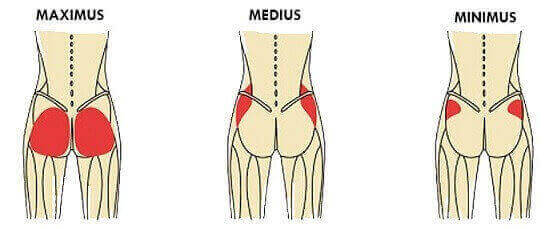
-
Gluteus Maximus
This is the main external muscle located on the surface of the butt that can be seen and is the largest layer between them. It generates the rounding shape of the butt, so once you exercise and train this area it will surprise you with the difference of a big change in its shape, to be well shaped and round and not a flat surface.
This muscle is connected to the bones of the hips and is mainly responsible for extensions and helps in rotational movements, especially for the lower part of the body, such as walking or running.
-
Gluteus Medius
Located on the upper outer part of the butt, it is responsible for raising the upper body to the sides and helping to rotate the leg. In addition, it provides balance to the pelvis while walking, which means that any dysfunction of the Medius muscle, will lead to problems with walking and running.
-
Gluteus Minimus
Similar responsibility to Medius to stabilize the pelvis and rotate the legs. It is the smallest muscle among the three layers of glutes and is located just below the Medius.
How to Stretch Glutes ?
Let’s list the stretching exercises that will help you loosen and stretch the tight glutes, and relieve pain.
1. Seated Leg Cradle
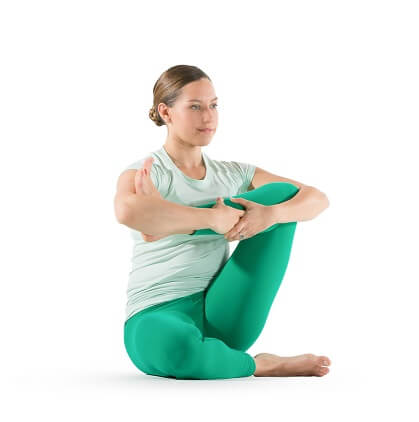
A quick result of gluteal stretching in this sitting position is obtained from the next day after performing the training, which will revive the sore glutes. But it requires high flexibility in the legs. So, Let’s start with that:
- Use a simple mat for your comfort. Start by sitting on the mat with your legs straight.
- Grab the right knee and draw toward your chest and hug this right leg by placing the right knee leg in the bend of the right elbow arm and the right foot in the left elbow bend. So that the right shin is perpendicular to your chest.
- Make sure to keep your back straight and start gently sliding slightly your right leg from left to right direction. You should start to feel squeeze with your right hip and buttock.
- Bend your left leg to the right.
- Hold for 30 seconds before you release your leg.
- Switch to the other side and start repeating the stretch steps with left leg.
Note: This stretch requires some flexibility and it’s not easy to perform, so you can adjust to the low intensity of the stretch by grabbing your foot and knee with your hands opposite of your chest. You can also put your back against the wall to stabilize the body.
2. Glute Foam Roll
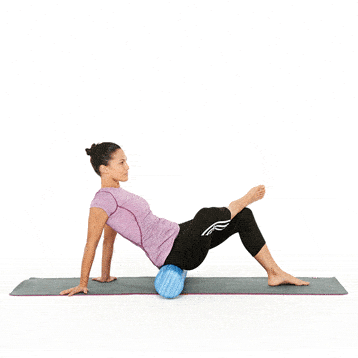
This extension required a foam roller tool.
- Begin by sitting on top of the foam roller, keeping your legs outstretched in front of you, and placing both palms on the floor behind you.
- Raise one leg by placing your foot above the knee of the other leg.
- Reposition your body so that the roller under you is between the sit bone and the hipbone.
- Now slowly roll out the glutes forward and then reverse back.
- Switch to the side of the other leg and repeat.
3. Standing figure-four Stretch
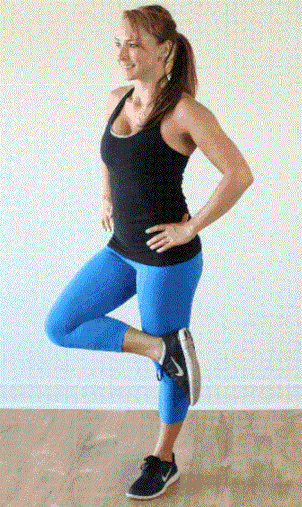
The standing figure 4 stretch is an exciting exercise while performing, it is one of the glute stretches in a standing positions that you can practice. Let’s start with:
- Stand and put your hands on your hips.
- Raise your leg and place it on top of your other knee, this will form a “four” number.
- While keeping your back and posture straight.
- Lower your upper body to about hip level as possible.
- Freeze this position for 4-6 seconds, then raise your body again, Repeat 4 times.
- Alternate stretching exercises to the other leg side.
Note: You can rest your back against a wall for more body balance.
4. Seated figure-four stretch
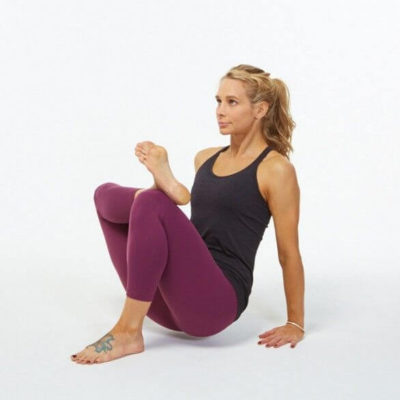
The sitting figure 4 stretch is similar to the Glute Foam Roll stretch, but without the foam roller tool, using only the body, as an alternative in the absence of roller equipment.
- Sit on the floor with a seated position, keeping your spine straight.
- Place your palm flat on the floor slightly behind you.
- Begin by crossing your right leg over your left leg by placing your right foot on the left knee.
- You can try bending your torso forward to stretch muscle deeper.
- Freeze this position for 10-12 seconds, then lower your leg to the floor.
- Switch to the other leg side and repeat.
Note: You can increase the intensity of the gluteal stretch. For the cross leg, pull your sole foot down more toward your hip, then continue with the stretching steps.
5. Seated twist
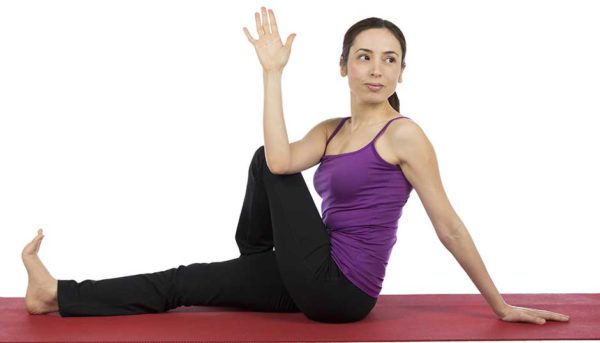
The seated twist is a great exercise that works just as well as the stretching exercises to relieve buttock pain.
- Start in a seated position on the floor, with your legs straight in front of you. Place both hands behind you with palms flat on the floor to support your lower back.
- Lift your left leg and then bend your left knee across the right over the right leg, placing your left foot flat on the floor, next to your right thigh.
- Twist your head to the left side, then place your right elbow on the left side of your left knee, your forearm in a straight vertical position.
- Take a deep breath in and out and hold this position for 10-12 seconds.
- Untwist the movement by switching to the other side and repeat.
6. Pigeon Pose (Pada Rajakapotasana)
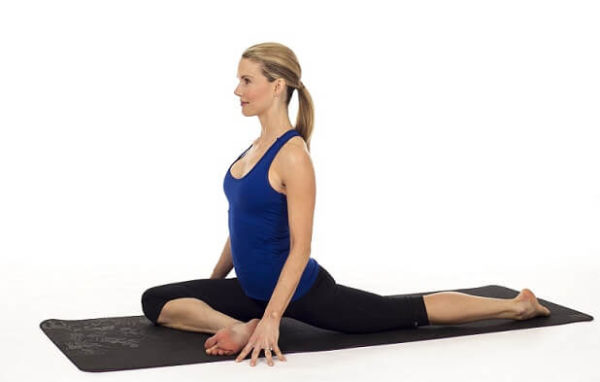
- Start by placing your hands and knees on the mat. Bring your left knee forward toward the left palm.
- Adjust your left shin on the floor with the ankle pointing toward the right palm. As much as possible, try to adjust the shin of the left leg to be parallel with the front of the mat.
- Then slide your right leg back to begin to feel more stretch.
- Keep your back straight and your head looking forward.
- Hold this position for 10 to 20 seconds (keep breathing in and out slowly).
- Slowly unlock the pose and repeat by switching to the other side.
7. Glute Bridge
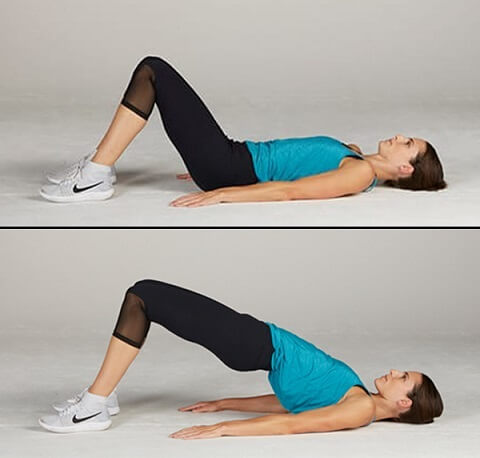
In this routine have other benefits than glute stretch for relieve lower back pain and strength of hamstrings and knees, how to perform that:
- Lie on your back on a mat with your knees bent and feet flat on the floor. Hands at your sides with palms on the floor.
- Set your feet hip-width apart and slowly contract your abdominal muscles.
- Exhale and start lifting your hips off the floor. While squeeze the muscles of the buttocks.
- Make sure your knees, hips and shoulders are tilted to be aligned on straight line.
- Hold this position for 3 – 6 seconds, inhale, then slowly lower your hips to the floor.
- Repeat 6 to 8 times.
The Glute Bridge exercise is a very important stretch, and it has many variations and their is enormous benefits for performance. If you need more details and instructions, please follow this link (Glute Bridges).
Causes of Tight Glutes?
There are many reasons for having the tight gluteal muscles, but usually they are:
- Sitting for a long period of time.
- Muscle soreness that occurs after workouts.
- Muscular fatigue caused by jumping or running.
- Lack of warm-up before any exercise.
- Poor body format during exercise.
- Poor Alignment Posture that causes back pain.
Summary
Tight glutes are a common problem for athletes, especially runners. Moreover, it has been raised for people who work in office jobs and remain seated for hours during the day.
It is significant to stretch the tight gluteal muscles and pay extra attention by keeping them engaged and flexible. This helps avoid muscle stiffness with potential injuries. Start practicing the above stretches 3 to 4 times a week to have flexible Tight Glutes.
For people with a severe injury, always get your doctor’s OK before beginning warm-up or stretching exercises.
In order to strengthen the glutes muscles, you can start performing the planned exercises using the guidance as well either follow workout Men Glutes or Women Glutes.
Your Comments
Share Your Glute stretches experiences with others, whether it’s your tips, ideas, advice, things that worked well for you, or any issues you’ve encountered!
